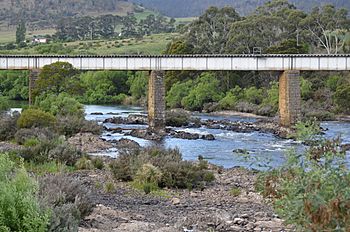Derwent Valley Railway (Tasmania) facts for kids
Quick facts for kids Derwent Valley Railway |
|
|---|---|

A railway bridge on the Derwent Valley Railway
|
|
| Overview | |
| Status | In use |
| Owner | Government of Tasmania |
| Termini | Bridgewater Kallista |
| Service | |
| Type | Heavy rail |
| Operator(s) | TasRail |
| History | |
| Opened | September 1, 1887 |
| Technical | |
| Track gauge | 3 ft 6 in (1,067 mm) |
The Derwent Valley Railway is a special heritage railway line in Tasmania, Australia. It is currently not running regular trains. Its main base is in New Norfolk. This railway uses a narrow gauge of 3 feet 6 inches.
Contents
History of the Derwent Valley Railway
How the Railway Started
The Tasmanian Government Railways first opened the Derwent Valley Line in 1887. It began at Bridgewater. This town is on the main north-south railway line from Hobart to Devonport. The first part of the line went to New Norfolk. This section was about 18 kilometers long.
Expanding the Line
Later in 1887, the railway was made longer. It reached Plenty, covering 29 kilometers. In 1888, it was extended again to Glenora, making it 41 kilometers long. The railway closely follows the River Derwent for most of its length. It even crosses the river three times!
Over the years, there were many ideas to extend the line. People wanted to connect it further up the Derwent Valley. Finally, in 1909, the line was extended another 8 kilometers. It followed the Tyenna River to what is now Westerway.
In 1917, another part was added to Fitzgerald, making the line 66 kilometers long. The very last extension opened in 1936. This took the railway to Kallista, which was 74 kilometers from Bridgewater. This new section replaced an older wooden tramway.
Why the Railway Was Important
The main reason for the railway was to serve farms and logging areas. It helped transport timber from places like Kallista. In 1940, a paper mill opened at Boyer. This mill was 14 kilometers from Bridgewater. It caused a big increase in log traffic on the railway. Because of this, new sections of track were built. More facilities were also added at several stations.
When Parts of the Railway Closed
Eventually, some parts of the railway started to close down. First, the smaller logging lines near Kallista were shut. Then, the section from Kallista to Florentine Junction closed. In 1995, TasRail completely closed the line past New Norfolk. This happened because floods and heavy rain badly damaged the tracks.
Bringing the Railway Back to Life
The Preservation Society's Work
In 1990, a group called the Derwent Valley Railway Preservation Society was formed. This society bought the equipment from another company. That company used to run special train trips on the line. The Society set up its main base in New Norfolk. They continued to run passenger trains to Maydena.
When the line closed beyond New Norfolk in 1995, the Society found other places to operate. Even though TasRail still owned the line, the Society worked hard. In 1999, they reopened the line to Hayes. Then, in 2000, it reopened to Westerway. By 2003, they had reopened it to National Park. This section was 37 kilometers from New Norfolk.
What the Society Has Now
The Society is now known as Derwent Valley Railway Inc. They have a collection of 11 locomotives. These include 4 steam engines and 7 diesel engines. They also have 9 passenger carriages and 11 freight wagons.
Before the line closed, two of TasRail's freight trains used the section from Bridgewater. They went to the Norske Skog paper mill at Boyer. One train carried paper to Burnie for export. The other brought coal and timber to the mill from northern Tasmania.
The Railway Today
In October 2005, a company called Pacific National took over running the TasRail network. They decided to close the Derwent Valley Line west of New Norfolk. This decision stopped the heritage railway from running. In May 2006, Pacific National made a new agreement with the Tasmanian Government. This agreement meant that all the tracks and railway land went back to government ownership.
As of July 2025, the Derwent Valley Railway Inc. is talking with the government. They hope to get access to the Derwent Valley Line again. Their goal is to fix the line and start running tourist trains once more.
See also
- Rail transport in Tasmania

